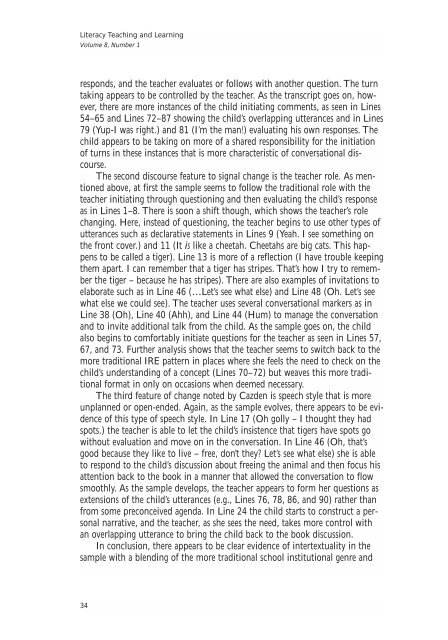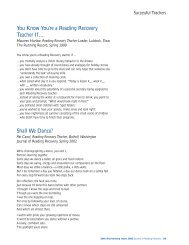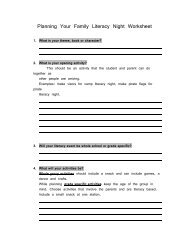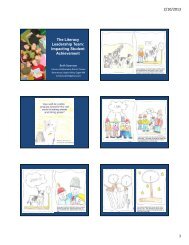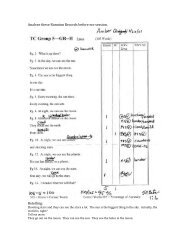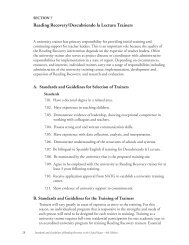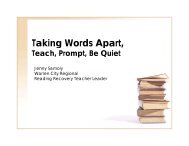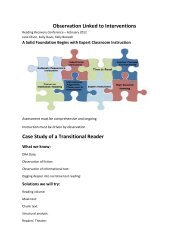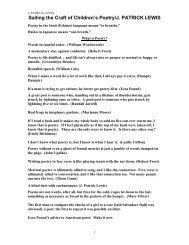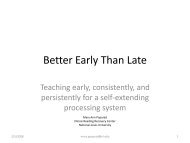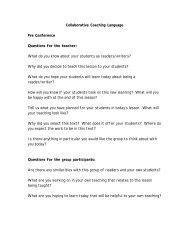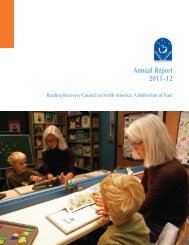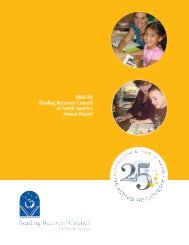Conversation As a Model of Instructional Interaction - Eric
Conversation As a Model of Instructional Interaction - Eric
Conversation As a Model of Instructional Interaction - Eric
Create successful ePaper yourself
Turn your PDF publications into a flip-book with our unique Google optimized e-Paper software.
layout-8/l-2003 1/7/04 12:29 PM Page 34Literacy Teaching and LearningVolume 8, Number 1responds, and the teacher evaluates or follows with another question. The turntaking appears to be controlled by the teacher. <strong>As</strong> the transcript goes on, however,there are more instances <strong>of</strong> the child initiating comments, as seen in Lines54–65 and Lines 72–87 showing the child’s overlapping utterances and in Lines79 (Yup-I was right.) and 81 (I’m the man!) evaluating his own responses. Thechild appears to be taking on more <strong>of</strong> a shared responsibility for the initiation<strong>of</strong> turns in these instances that is more characteristic <strong>of</strong> conversational discourse.The second discourse feature to signal change is the teacher role. <strong>As</strong> mentionedabove, at first the sample seems to follow the traditional role with theteacher initiating through questioning and then evaluating the child’s responseas in Lines 1–8. There is soon a shift though, which shows the teacher’s rolechanging. Here, instead <strong>of</strong> questioning, the teacher begins to use other types <strong>of</strong>utterances such as declarative statements in Lines 9 (Yeah. I see something onthe front cover.) and 11 (It is like a cheetah. Cheetahs are big cats. This happensto be called a tiger). Line 13 is more <strong>of</strong> a reflection (I have trouble keepingthem apart. I can remember that a tiger has stripes. That’s how I try to rememberthe tiger – because he has stripes). There are also examples <strong>of</strong> invitations toelaborate such as in Line 46 (…Let’s see what else) and Line 48 (Oh. Let’s seewhat else we could see). The teacher uses several conversational markers as inLine 38 (Oh), Line 40 (Ahh), and Line 44 (Hum) to manage the conversationand to invite additional talk from the child. <strong>As</strong> the sample goes on, the childalso begins to comfortably initiate questions for the teacher as seen in Lines 57,67, and 73. Further analysis shows that the teacher seems to switch back to themore traditional IRE pattern in places where she feels the need to check on thechild’s understanding <strong>of</strong> a concept (Lines 70–72) but weaves this more traditionalformat in only on occasions when deemed necessary.The third feature <strong>of</strong> change noted by Cazden is speech style that is moreunplanned or open-ended. Again, as the sample evolves, there appears to be evidence<strong>of</strong> this type <strong>of</strong> speech style. In Line 17 (Oh golly – I thought they hadspots.) the teacher is able to let the child’s insistence that tigers have spots gowithout evaluation and move on in the conversation. In Line 46 (Oh, that’sgood because they like to live – free, don’t they? Let’s see what else) she is ableto respond to the child’s discussion about freeing the animal and then focus hisattention back to the book in a manner that allowed the conversation to flowsmoothly. <strong>As</strong> the sample develops, the teacher appears to form her questions asextensions <strong>of</strong> the child’s utterances (e.g., Lines 76, 78, 86, and 90) rather thanfrom some preconceived agenda. In Line 24 the child starts to construct a personalnarrative, and the teacher, as she sees the need, takes more control withan overlapping utterance to bring the child back to the book discussion.In conclusion, there appears to be clear evidence <strong>of</strong> intertextuality in thesample with a blending <strong>of</strong> the more traditional school institutional genre and34


